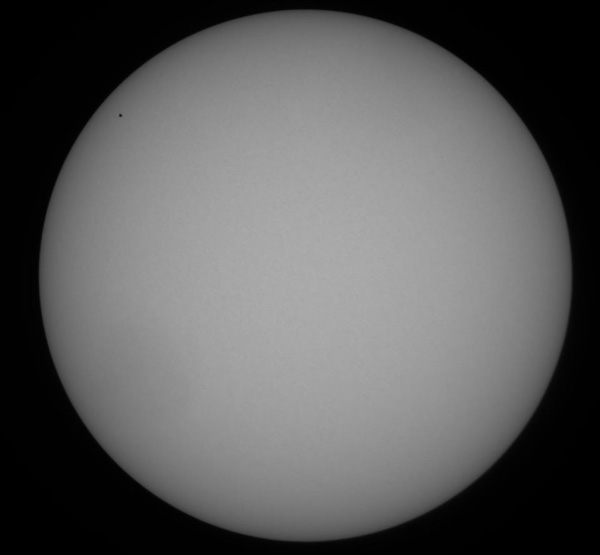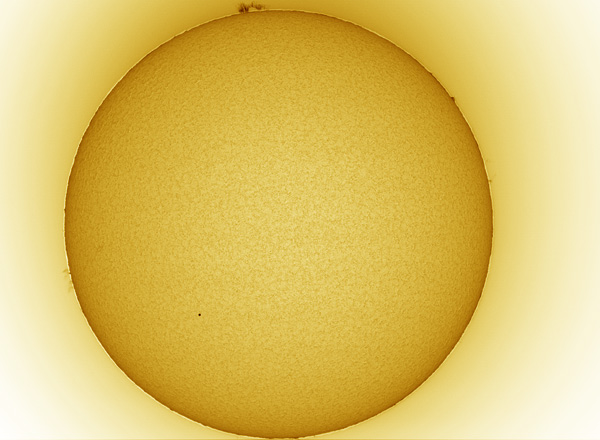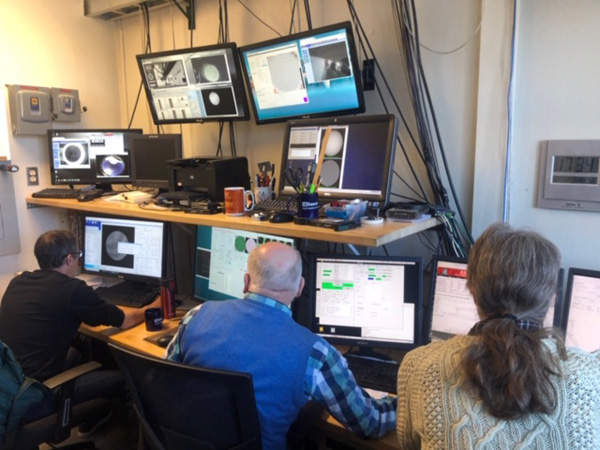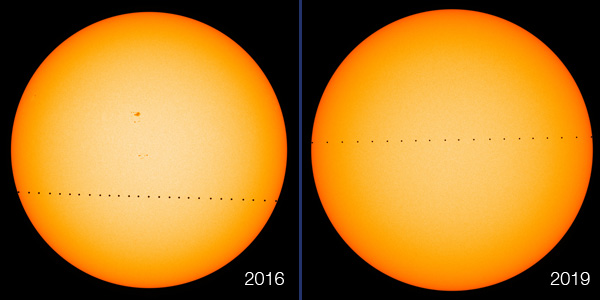Though clouds blocked the sky for many yesterday, those with a clear view had the chance to see tiny Mercury cross the face of the Sun. Enjoy the results — it won't happen again until 2032.
On Monday, November 11th, Mercury crossed the Sun for the last time until 2032. The transit took 5½ hours, so it wasn't exactly a dashing sight. Yet the view — for those who had one (the offices of S&T were sadly clouded out) — was nevertheless captivating. The sky so often appears two-dimensional, but Mercury's transit is one of the few views that reveals all three dimensions of our solar system.
Mercury is tiny with respect to the Sun: As it crossed, it only covered 0.001% of the Sun's surface. So anyone watching the transit yesterday was looking through a telescope. Of course, this requires filtering to protect eyes from the Sun's magnified light, but it also offers the option to use several different filters to reveal different aspects of the Sun.
This video by Stephen Ramsden, of the Charlie Bates Solar Astronomy Project, shows the Sun at various levels of magnifications through hydrogen-alpha and calcium-K filters, as well as a white-light view:
Despite the weather system that clouded out many areas, the Citizen ToM project was able to collected some good data from at least 10 sites, reports Zack Stockbridge. Ultimately, this collection of citizen scientists aims to use multiple points of view of the transit to re-calculate the distance from Earth to the Sun. Measuring the astronomical unit was essential to astronomers a couple centuries ago as they attempted to understand the full span of our solar system.

Zack Stockbridge

Zack Stockbridge
Jay Pasachoff (Williams College) led a team observing the transit with the 1.6-meter Goode Solar Telescope at the Big Bear Solar Observatory in California. The team also employed a second site at Embry-Riddle Aeronautical University for another view of the transit, as part of an international collaboration to precisely measure the astronomical unit.

Jay Pasachoff
Two composites that combine images from the SDO taken 21 minutes apart show how yesterday's transit differs from the one in May 2006.

SDO / HMI / Monica Bobra
Did you see the transit? Tell us about your observations below in the comments!
See more transit of Mercury images — and submit your own! — in our online gallery.
 10
10









Comments
ERIC T
November 12, 2019 at 4:06 pm
Was clouded out until 1030 am local time in S. Carolina. i had beautiful clear skies for the remainder of the transit. got a chance to take a few photos.
You must be logged in to post a comment.
Anthony Barreiro
November 12, 2019 at 7:28 pm
I had a great time observing the Mercury transit from the top of Bernal Hill in San Francisco. Along with several friends from my astronomy club and a couple of other amateurs from the neighborhood, we had three refractors with Hydrogen alpha filters, a refractor with a white light filter, and a reflector with a white light filter. The Sun rose at 6:46 am PST, 35 minutes before the middle of the transit. The sky was fairly clear at sunrise and Mercury was clearly visible as a little black dot in the middle of the Sun. Between about 7:15 and 8:15 we had patchy thick fog that sometimes obscured the view. Then we had a couple of hours of slightly hazy but otherwise clear skies and good seeing until the transit ended at 10:05. The best view imo was through a refractor with a heated H-alpha filter, but everybody had good views.
We had a lot of passersby, people walking their dogs, jogging, or just out for a walk. More than half of them had heard about the transit and were happy to see it. Most of the rest were pleasantly surprised. As always, there were a few people who were too busy to spend 30 seconds looking through an eyepiece. Oh well, they can wait until 2032 for the next one.
You must be logged in to post a comment.
steve-callio
November 12, 2019 at 7:52 pm
Early snow in the Denver area followed by clouds. Then at about 10:50 MST I got a view with shielded 12 x 36 imaged stabilized binocs. Used the homemade solar filter (high quality as per a S&T article ) from the solar eclipse a few years back. The view between the clouds lasted about a minute. Views through clouds showed the solar disk and fast moving clouds but not Mercury. The best view showed Mercury as an obvious dot but my view was SO short. A few minutes later the transit was over. I could not see any sun spots at all.
You must be logged in to post a comment.
Rod
November 12, 2019 at 7:56 pm
Anthony, glad to see your report here and that you were able to see the Mercury transit. I posted some comments on Bob King's report, here is a note for this page. I viewed in Maryland yesterday. "This was a great event to observe! I was out early and at 0713 EST, the Sun rose above a tree line on the horse farm I viewed from. At 40x, I could see Mercury black disk shape on the solar limb near 0737 EST, that was 2nd contact of ingress. Temps were near 5C with dew and light fog around, cirrus clouds too. I observed through out the day and viewed Mercury from 40x to 71x. Near 1200 EST, the cirrus clouds started moving away with plenty of blue sky. The last 60 minutes of the Mercury transit, skies provided great views here. Near 1302 EST at 71x, I could see Mercury next to the solar limb, soon to depart. By 1304 EST, Mercury no longer visible. I used my flip, cell phone for time checks Outdoors today, some deer hunters were using their muzzle loaders. Two immature eagles were flying around me and my pasture areas too, distinct calls and sight. Likely young eagles that have not departed the nesting areas along the Patuxent river for winter. Various flocks of birds flew across my telescope view too, especially early shortly after Mercury ingress time. I used my 90-mm refractor with white light solar filter, 25-mm plossl and 14-mm Delos eyepieces. The tripod is alt-azimuth with cable, slow motion controls. The Sun is a bit more than 0.5-degree diameter in the field of view and Mercury near 10" angular size. My eyepieces provided 1.3 and 1.0 degree, true field of views. Even thought at times cirrus clouds moved by, the cirrus did not block out my views of the Sun and Mercury. The next Mercury transit viewable in our location will be 07-May, 2049 or nearly 30 years. My stargazing log is now all updated--Rod"
You must be logged in to post a comment.
Donald Bruns
November 12, 2019 at 11:42 pm
Weather was slightly hazy in San Diego, after some earlier fog, but at 9am I was able to see Mercury using 7x50 binoculars. I taped a 2017 eclipse eyeglass to one front aperture, so the effective diameter was only 30mm; the other aperture was covered with a taped-on lens cap. I was able to follow Mercury until just after 10am, a few minutes before the transit was over. I propped up the binocular on a table to stabilize it, but the small disc was easy to detect at 7x.
You must be logged in to post a comment.
kevin-bourque
November 13, 2019 at 7:31 am
We had occasional high clouds in Charleston SC but I saw the whole thing. I taped a pair of cardboard eclipse glasses over my Canon IS 10x30 binoculars and saw Mercury very clearly. It photographed well with a 500mm mirror lens.
The Sun had one spot that day, but only for a little while.
You must be logged in to post a comment.
bob kelly
November 13, 2019 at 12:46 pm
Saw the transit at Rye Playland, north of New York City. Rolls of thick clouds threatened to end our viewing, but they only lasted from 8 to 9am. A variable-thickness deck of high clouds the rest of the time.
Lots of people stopped to look: joggers, dog walkers and families visiting the adjoining Westchester Children's Museum. Our Westchester Astronomers worked with the 2024Totality solar observing group.
At my blog, https://bkellysky.wordpress.com/2019/11/11/transit-if-mercury-across-the-sun/ is a snap of the sun and Mercury taken with my iPhone through my filtered 8-inch dobsionian. Our guests were able to pick out the tiny planetary photobomber in my 40x 2-inch eyepiece. Our viewers agreed Mercury looked about the size of a bold period at the end of a sentence.
You must be logged in to post a comment.
Bill -Simpson
November 14, 2019 at 1:30 am
I got a good view of it in Slidell, Louisiana, using a Coronado PST solar telescope and an Orion 9.5mm Epic ED-2 long eye relief eyepiece. It was before the cold front arrived, so it was hot under a dark shirt I used to block out the light. It was nice to have seen both the transit of Venus and Mercury.
Having seen both transits made me wonder if there is ever a dual transit of both planets, and if Venus ever eclipses Mercury during a solar transit? The Sun might consume them both before that has a chance to happen.
You must be logged in to post a comment.
Anthony Barreiro
November 14, 2019 at 7:25 pm
According to wikipedia, there was a simultaneous transit of Venus and Mercury on 22 September 373,173 BCE. There will be another on 29 March 224,508 CE. I question the validity of these calculations. The orbital inclinations and periods of all three planets -- Mercury, Venus, and Earth -- change in unpredictable ways. Over the course of hundreds of years, or thousands of years, these changes may have an insignificant effect on the geometry of a transit. But over *hundreds of thousands* of years? I doubt that it's possible to know exactly where all three planets were four hundred thousand years ago, or exactly where they will all be two hundred thousand years from now.
You must be logged in to post a comment.
Bob
November 14, 2019 at 12:33 pm
Nice article.
Has Jay Pasachoff published anything lately? Would be nice to learn.
And my second question for Jay -- Where is Williams College? .
You must be logged in to post a comment.
You must be logged in to post a comment.